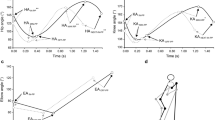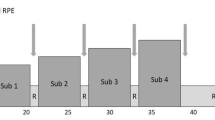Abstract
The purpose of the study was to examine the biomechanical-physiological effects of different frequencies using the double poling technique in cross-country skiing. Nine elite skiers roller-skied using poling frequencies of 40, 60 and 80 cycles·min−1 (Pf40, Pf60, Pf80) at submaximal treadmill speeds (12, 18, 24 km·h−1). Cycle characteristics, pole forces, joint angles and physiological responses were measured. Comparing Pf40 versus Pf60 versus Pf80 (all variables different at P < 0.05), absolute poling time decreased by up to 46%, as did absolute and relative (% cycle time) recovery times, at almost all speeds. Peak force, impulse of force and time to peak force decreased, whereas impact force increased with frequency at almost all speeds. Elbow ranges of motion and angular velocities, hip and knee angle maxima and flexion/extension ranges of motion per cycle decreased, whereas hip and knee angle minima, ranges of motion per minute and angular extension velocities during recovery phase all increased with frequency at nearly all speeds. Oxygen uptake and heart rate increased up to 13% (Pf40–60 versus Pf80) at all speeds. Pulmonary ventilation increased most distinctly at the highest speed. Blood lactate was lowest at Pf60 and highest at Pf80 (J-shape curve) at 24 km·h−1. Gross efficiency decreased with higher frequency at all speeds. These results demonstrate different biomechanical and physiological demands at different frequencies with the beneficial effects of lower poling frequencies at submaximal speeds. For training purposes, we suggest that cross-country skiers would benefit by training with different poling frequencies to vary their training load.






Similar content being viewed by others
References
Aaron EA, Seow KC, Johnson BD, Dempsey JA (1992) Oxygen cost of exercise hyperpnea: implications for performance. J Appl Physiol 72:1818–1825
Ahlborg G, Jensen-Urstad M (1991) Metabolism in exercising arm vs leg muscle. Clin Physiol 11:459–468
Ainegren M, Carlsson P (2008) Rolling resistance for treadmill roller skiing. Sports Eng 11:23–29
Bartlett RG Jr, Brubach HF, Specht H (1958) Oxygen cost of breathing. J Appl Physiol 12:413–424
Bilodeau B, Rundell KW, Roy B, Boulay MR (1996) Kinematics of cross-country ski racing. Med Sci Sports Exerc 28:128–138
Bosco C, Komi PV, Ito A (1981) Prestretch potentiation of human skeletal muscle during ballistic movement. Acta Physiol Scand 111:135–140
Bosco C, Tihanyi J, Komi PV, Fekete G, Apor P (1982) Store and recoil of elastic energy in slow and fast types of human skeletal muscles. Acta Physiol Scand 116:343–349
Buchthal F, Schmalbruch H (1970) Contraction times and fibre types in intact human muscle. Acta Physiol Scand 79:435–452
Cavagna GA, Saibene FP, Margaria R (1964) Mechanical work in running. J Appl Physiol 19:249–256
Chavarren J, Calbet JA (1999) Cycling efficiency and pedalling frequency in road cyclists. Eur J Appl Physiol Occup Physiol 80:555–563
Coast JR, Rasmussen SA, Krause KM, O’Kroy JA, Loy RA, Rhodes J (1993) Ventilatory work and oxygen consumption during exercise and hyperventilation. J Appl Physiol 74:793–798
Dempsey JA, Johnson BD, Saupe KW (1990) Adaptations and limitations in the pulmonary system during exercise. Chest 97:81S–87S
Di Martino L, Dessena M, Demontis B, Grosso LP, Murenu G (2000) Clinical management of soft tissue sarcomas. Chir Ital 52:343–349
di Prampero PE, Ferretti G (1999) The energetics of anaerobic muscle metabolism: a reappraisal of older and recent concepts. Respir Physiol 118:103–115
Dillman C (1979) Biomechanical determinations of effective cross-country skiing techniques. J US Ski Coaches Assoc 3:38–42
Eberstein A, Goodgold J (1968) Slow and fast twitch fibres in human skeletal muscle. Am J Physiol 215:7
Ekström H (1980) Biomechanical research applied to skiing. A developmental study and an investigation of cross-country skiing, alpine skiing and knee ligaments. Department of Biomechanical Engineering. Linköping University, Linköping, p 123
Fabre N, Perrey S, Arbez L, Rouillon JD (2007) Paced breathing in roller-ski skating: effects on metabolic rate and poling forces. Int J Sports Physiol Perform 2:46–57
Foss O, Hallen J (2005) Cadence and performance in elite cyclists. Eur J Appl Physiol 93:453–462
Garnett R, O’Donovan MJ, Stephens JA, Taylor A (1978) Evidence for the existence of three motor unit types in normal human gastrocnemius [proceedings]. J Physiol 280:65P
Gollhofer A, Schmidtbleicher D, Dietz V (1984) Regulation of muscle stiffness in human locomotion. Int J Sports Med 5:19–22
Griffin TM, Roberts TJ, Kram R (2003) Metabolic cost of generating muscular force in human walking: insights from load-carrying and speed experiments. J Appl Physiol 95:172–183
Henke KG, Sharratt M, Pegelow D, Dempsey JA (1988) Regulation of end-expiratory lung volume during exercise. J Appl Physiol 64:135–146
Hoffman MD, Clifford PS, Bender F (1995) Effects of velocity on cycle rate and length for three roller skiing techniques. J Appl Biomech 11:257–266
Holmberg HC (2005) Physiology of cross-country skiing–with special emphasis on the role of the upper body. Department of Physiology and Pharmacology. Karolinska Institutet, Stockholm, p 77
Holmberg HC, Calbet JA (2007) Insufficient ventilation as a cause of impaired pulmonary gas exchange during submaximal exercise. Respir Physiol Neurobiol 157:348–359
Holmberg H-C, Lindinger S, Stöggl T, Eitzlmaier E, Müller E (2005) Biomechanical analysis of double poling in cross-country skiing. Med Sci Sports Exerc 37:807–818
Holmberg HC, Lindinger S, Stoggl T, Bjorklund G, Muller E (2006) Contribution of the legs to double-poling performance in elite cross-country skiers. Med Sci Sports Exerc 38:1853–1860
Ishikawa M, Komi PV (2004) Effects of different dropping intensities on fascicle and tendinous tissue behavior during stretch-shortening cycle exercise. J Appl Physiol 96:848–852
Ishikawa M, Komi PV (2008) Muscle fascicle and tendon behavior during human locomotion revisited. Exerc Sport Sci Rev 36:193–199
Komi PV (2000) Stretch-shortening cycle: a powerful model to study normal and fatigued muscle. J Biomech 33:1197–1206
Komi PV, Gollhofer A (1997) Stretch reflexes can have an important role in force enhancement during SSC exercise. J Appl Biomech 13:451–460
Komi PV, Norman RW (1987) Preloading of the thrust phase in cross-country skiing. Int J Sports Med 8(Suppl 1):48–54
Kuitunen S, Komi PV, Kyrolainen H (2002) Knee and ankle joint stiffness in sprint running. Med Sci Sports Exerc 34:166–173
Lindinger SJ, Göpfert C, Stöggl T, Müller E, Holmberg H (2009a) Biomechanical pole and leg characteristics during uphill diagonal roller skiing. Sports Biomech 8:318–333
Lindinger SJ, Holmberg HC, Muller E, Rapp W (2009b) Changes in upper body muscle activity with increasing double poling velocities in elite cross-country skiing. Eur J Appl Physiol 106:353–363
Lindinger SJ, Stoggl T, Muller E, Holmberg HC (2009c) Control of speed during the double poling technique performed by elite cross-country skiers. Med Sci Sports Exerc 41:210–220
Magnusson SP, Narici MV, Maganaris CN, Kjaer M (2008) Human tendon behaviour and adaptation, in vivo. J Physiol 586:71–81
Manohar M (1987) Blood flow in respiratory muscles during maximal exertion in ponies with laryngeal hemiplegia. J Appl Physiol 62:229–237
Marais G, Pelayo P (2003) Cadence and exercise: physiological and biomechanical determinants of optimal cadences–practical applications. Sports Biomech 2:103–132
Margaria R, Milic-Emili G, Petit JM, Cavagna G (1960) Mechanical work of breathing during muscular exercise. J Appl Physiol 15:354–358
McKerrow CB, Otis AB (1956) Oxygen cost of hyperventilation. J Appl Physiol 9:375–379
Millet GY, Hoffman MD, Candau RB, Buckwalter JB, Clifford PS (1998a) Cycle rate variations in roller ski skating: effects on oxygen uptake and poling forces. Int J Sports Med 19:521–525
Millet GY, Hoffman MD, Candau RB, Clifford PS (1998b) Poling forces during roller skiing: effects of technique and speed. Med Sci Sports Exerc 30:1645–1653
Minetti AE (2004) Passive tools for enhancing muscle-driven motion and locomotion. J Exp Biol 207:1265–1272
Mittelstadt SW, Hoffman MD, Watts PB, O’Hagan KP, Sulentic JE, Drobish KM, Gibbons TP, Newbury VS, Clifford PS (1995) Lactate response to uphill roller skiing: diagonal stride versus double pole techniques. Med Sci Sports Exerc 27:1563–1568
Mure M, Lindahl SG (2001) Prone position improves gas exchange–but how? Acta Anaesthesiol Scand 45:150–159
Mure M, Domino KB, Lindahl SG, Hlastala MP, Altemeier WA, Glenny RW (2000) Regional ventilation-perfusion distribution is more uniform in the prone position. J Appl Physiol 88:1076–1083
Myers MJ, Steudel K (1985) Effect of limb mass and its distribution on the energetic cost of running. J Exp Biol 116:363–373
Nilsson J, Tveit P, Eikrehagen O (2004) Effects of speed on temporal patterns in classical style and freestyle cross-country skiing. Sports Biomech 3:85–107
Norman RW, Komi PV (1985) Differences in body segment energy utilization between world-class and recreational cross-country skiers. Int J Sport Biom 1:253–262
Peronnet F, Massicotte D (1991) Table of nonprotein respiratory quotient: an update. Can J Sport Sci 16:23–29
Piriyaprasarth P, Morris ME, Winter A, Bialocerkowski AE (2008) The reliability of knee joint position testing using electrogoniometry. BMC Musculoskelet Disord 9:6
Radegran G, Saltin B (1998) Muscle blood flow at onset of dynamic exercise in humans. Am J Physiol 274:H314–H322
Saltin B, Radegran G, Koskolou MD, Roach RC (1998) Skeletal muscle blood flow in humans and its regulation during exercise. Acta Physiol Scand 162:421–436
Sandbakk Ø, Holmberg HC, Leirdal S, Ettema G (2010) Metabolic rate and gross efficiency at high work rates in world class and national level sprint skiers. Eur J Appl Physiol 109:473–481
Smith GA (2002) Biomechanics of cross country skiing. In: Rusko H (ed) Cross country skiing: olympic handbook of sports medicine. Blackwell Publishing, Oxford, pp 32–61
Stoeggl T, Lindinger S, Muller E (2007) Analysis of a simulated sprint competition in classical cross country skiing. Scand J Med Sci Sports 17:362–372
Stöggl TL, Müller E (2009) Kinematic determinants and physiological response of cross-country skiing at maximal speed. Med Sci Sports Exerc 41:1476–1487
Vähäsöyrinki P, Komi PV, Seppala S, Ishikawa M, Kolehmainen V, Salmi JA, Linnamo V (2008) Effect of skiing speed on ski and pole forces in cross-country skiing. Med Sci Sports Exerc 40:1111–1116
Van der Woude LH, Veeger HE, Rozendal RH, Sargeant AJ (1989) Optimum cycle frequencies in hand-rim wheelchair propulsion: wheelchair propulsion technique. Eur J Appl Physiol Occup Physiol 58:625–632
Vercruyssen F, Brisswalter J (2010) Which factors determine the freely chosen cadence during submaximal cycling? J Sci Med Sport 13:225–231
Winter DA (1990) Biomechanics and motor control of human movement. Wiley, New York
Acknowledgments
The authors would like to express their appreciation for the helpful data analysis support in this study supplied by Caroline Göpfert. We would also like to thank Laboratory engineer Mats Ainegren for his highly valuable assistance during measurements and Prof. Dave Bacharach (St. Cloud State University, USA) for his useful comments on the manuscript. In particular, we thank the athletes who participated in this study. This investigation was supported financially by grants from the Swedish Olympic Committee and was supported by the Department of Sport Science and Kinesiology, University of Salzburg.
Author information
Authors and Affiliations
Corresponding author
Additional information
Communicated by Jean-René Lacour.
Rights and permissions
About this article
Cite this article
Lindinger, S.J., Holmberg, HC. How do elite cross-country skiers adapt to different double poling frequencies at low to high speeds?. Eur J Appl Physiol 111, 1103–1119 (2011). https://doi.org/10.1007/s00421-010-1736-8
Accepted:
Published:
Issue Date:
DOI: https://doi.org/10.1007/s00421-010-1736-8




